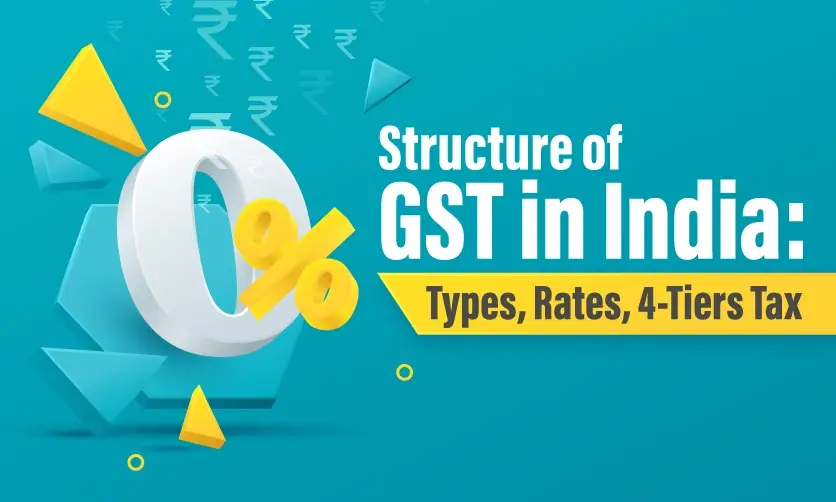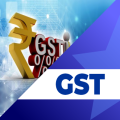
Structure of GST in India: Types, Rates, 4-Tiers Tax
On July 1st, 2017, the Goods and Services Tax (GST), was introduced in the Indian tax system. The main motive behind this is to streamline the complex tax structure of the state and central government and create a more transparent tax system. In the complete structure of GST in India, there are many things to learn and know, especially for business.
Understanding the GST tax structure in India is crucial for businesses of all sizes to know for smooth operations. This blog will explain the structure of GST in India, its objectives, its importance, and the 4-tier GST tax structure in India.
Let’s dive into the structure of GST and understand its key components.
Table of Contents
Objectives of Goods and Services Tax (GST)
Before introducing anything, there is an objective that we want to achieve, and the same is true with the GST tax structure in India. Check out the three main objectives of this:
- Simplify the tax system: GST replaces the multiple tax system of India with a single tax. Thus, it removes cascading taxes and increases transparency for businesses.
- Boost economic growth: After implementing GST, the interstate movement of goods becomes easy. This ultimately reduces trade barriers and transaction costs and helps with economic growth.
- Improve tax administration: The most important part of the complete GST tax structure in India is that it reduces the compliance burden on businesses. The centralized GST system notices increased revenue collection with improved transparency and trust in the government.
What we have left in the Old tax structure in India. Let’s take a look at the previous tax structure and understand why GST is Good for the Indian tax system.
Previous Tax Structure Overview
Multiple different types of taxes exist in the previous tax structure of India. We have mentioned below these taxes for your understanding:
- Central Level: Central Excise Duty (CED), Service Tax, Additional Duties of Excise (CVD), Special Additional Duty (SAD), Countervailing Duty (CVD)
- State Level: Value Added Tax (VAT), Entry Tax, Octroi Duty, Luxury Tax
All the above-mentioned taxes are applied at different rates across different states, in India. This makes the whole tax system more complex, including the cascading effect of taxes inflating the final price of goods and services.
If you are looking for a more relevant article on GST that enhances your knowledge, then visit here:
What is the Structure of GST in India?
The Goods and Services Tax (GST) is a tax collected at the final point of consumption instead of each point of production. This tax system works with a dual system. This means the Central Government charges the Central GST (CGST) and the State Government charges the State GST (SGST) for transactions within a state.
In addition to that for interstate supplies, an Integrated GST (IGST) is received by the Central Government. Even, some states and union territories levy a UTGST (Union Territory GST) on intra-UT supplies.
Here’s a simplified breakdown of the structure of GST in India:
- Intra-State Supply: CGST + SGST = Total GST (For example, If goods are sold from a factory in Delhi to a retailer in Delhi)
- Inter-State Supply: IGST = Total GST (For example, Consider a manufacturer selling goods from a factory in Amritsar to a retailer in Mumbai)
- Intra-UT Supply (in UT with legislature): CGST + UTGST = Total GST (For example, Sale of goods from a factory in Chandigarh to a retailer in Chandigarh)
Tax Rates: Based on goods and services types, different GST rates are applied. Check out the table below for more detailed information:
| Tax Rate | Goods/Services |
|---|---|
| 0% | Essential items like milk, bread, cereals, etc. |
| 5% | |
| 12% | The most commonly consumed goods and services |
| 18% | Majority of goods and services |
| 28% |
Input Tax Credit (ITC): An important feature, that makes this complete GST tax structure in India more beneficial for businesses is ITC. In simple terms, input tax credit allows businesses to claim credit for the GST paid on their purchases (inputs) when they make taxable supplies (outputs).
This tax system removes the complexity of double taxation and ensures a fair and transparent tax system.
The most important benefit of the structure of GST in India is the implementation of input tax credits. Do you have any idea how it works or what it is? Check out here to learn about ITC here:
Input Tax Credit under GST: Eligibility, Claims, and Process
Structure of GST: Key Components
I hope now you have some basic idea about the Structure of GST in India. However, this tax system works on different components that make it a stronger and more transparent tax system. Take a look at its key components:
- Central Goods and Services Tax (CGST): CGST is collected by the central government on the supply of goods and services within a state. Based on the types of goods supplied, the different tax rates are charged (0%, 5%, 12%, 18%, or 28%).
- State Goods and Services Tax (SGST): The state government collects the SGST on the supply of goods and services within a state. Similarly to CGST, goods fall under different tax slabs according to their types.
- Integrated Goods and Services Tax (IGST): When the goods or services are supplied between states or union territories, then the central government. The IGST rate is typically the sum of the CGST and SGST rates applicable to a specific good or service.
- Union Territory Goods and Services Tax (UTGST): UTGST is applied in union territories with a legislature (like Puducherry and Delhi). It works similarly to SGST but is collected by the union territory government.
All these components are important for businesses to understand and navigate properly in the business landscape. If you want to learn more about the basic GST structure in India in depth or are interested in learning complete GST, explore the courses here:

What is the 4-Tier GST Tax Structure?
The 4-tier GST tax structure in India was introduced by the GST Council. This 4 tier tax structure classifies goods and services based on their essentiality and value. This structure determines the applicable GST rate for each category:
0% Rate
In this tax slab category, the most essential items are covered. We have listed the below items that fall under this category:
| Category | Examples |
|---|---|
| Essential Food Items | Milk, curd, buttermilk, cheese (excluding processed), fresh fruits & vegetables, cereals (rice, wheat, and, maize), flour (atta), pulses (dals), sugar (excluding refined), honey, and salt |
| Basic Necessities | Eggs, bread (unbranded atta), newspapers, textiles (up to a certain value), kajal, kumkum, bindis |
| Educational Materials | Books, printed maps, exercise notebooks |
| Agricultural Products | Most live animals, fresh fish, seeds for agriculture, silkworm cocoons |
| Public Services | Public transport (buses, metros, railways, autorickshaws – not hired) |
| Renewable Energy Products | Solar panels, windmills, and biogas plants |
5% Rate
In this category, only a few essential goods or services are covered. To know the complete list, check out below:
| Category | Examples |
|---|---|
| Processed Food Items | Milk powder, butter (branded), skimmed milk powder, spices (excluding cloves), certain bakery items (rusk, biscuits) |
| Textiles (Limited Value) | Cotton fabrics and ready-made garments (up to ₹1,000 per piece) |
| Restaurant Services | Restaurant bills below ₹1,000 (without liquor) |
| Other Goods | Coal, newspapers (beyond a certain daily circulation), certain sanitary napkins, umbrellas |
12% Rate
This tax bracket includes a large range of commonly consumed goods and services. We have mentioned the full list of goods or services that fall under this tax category:
| Category | Examples |
|---|---|
| Clothing & Footwear (Mid-Range) | Most non-luxury clothing and footwear (above ₹1,000 per piece) |
| Household Appliances | Non-luxury appliances like fans, irons, toasters, mixers, and grinders (excluding air conditioners) |
| Electronics (Mid-Range) | Televisions (up to a certain screen size), mobile phones (excluding premium models) |
| Furniture | Most furniture items (excluding luxury furniture) |
| Processed Food Items | Certain processed food items (sauces, jams, and breakfast cereals) |
| Restaurants | Restaurant bills above ₹1,000 (without liquor) |
| Transportation Services | Taxis, auto-rickshaws (hired) |
| Construction Materials | Cement, bricks, and tiles (excluding certain types) |
| Personal Care Products | Soaps, shampoos, and toothpaste (excluding premium brands) |
| Stationery Items | Pens, pencils, and notebooks (excluding high-end stationery) |
18% Rate
The majority of goods and services fall under the 18% tax bracket:
| Category | Examples |
|---|---|
| Electronics (Premium) | High-end mobile phones, laptops, televisions (large screens), cameras |
| Appliances (Premium) | Air conditioners, refrigerators, washing machines, dishwashers |
| Furniture (Luxury) | Luxury furniture made from premium materials |
| Automobiles | Cars and motorcycles (excluding two-wheelers below a certain engine capacity) |
| Jewellery | Gold, diamonds, and other precious metal jewelry |
| Leather Products | Leather jackets, handbags, and wallets (excluding essential items like belts) |
| Processed Food Items (Luxury) | Chocolates, ice creams, processed meats, and branded breakfast cereals |
| Restaurants (Luxury) | Fine dining restaurants serving high-end cuisine |
| Services | Hotel accommodation (above ₹7,501 per day), salon services, gym memberships |
| Building Materials (Luxury) | Marble, granite, and imported tiles |
28% Rate:
The last one is a 28% GST tax that is applied to luxury goods like jewelry, automobiles (above a certain value), and other products like:
| Category | Examples |
|---|---|
| Luxury Cars | Cars exceeding a certain engine capacity or exceeding a specified ex-showroom price |
| Luxury Motorcycles | High-powered motorcycles exceeding a certain engine capacity |
| Aerated Drinks | Carbonated beverages like colas, and soda water |
| Tobacco Products | Cigarettes, cigars, and chewing tobacco |
| Gambling & Betting Services | Casino entry fees, lottery tickets |
| Video Game Consoles | Gaming consoles and video games |
| Certain Leisure Services | Amusement park entry fees, race club memberships |
| Yachts & Airplanes | Private jets, luxury yachts |
| Weapons & Ammunition | Firearms, and ammunition (excluding those meant for defense purposes) |
Businesses must ensure that correct GST is applied to their product to comply with tax laws. In the next section of the article. We will explain the importance of the structure of GST in India.
If you are interested in learning more about the different goods and their GST rate then visit here: Rate of GST on Goods
If you are interested in learning more about GST then explore the articles here
Importance of Understanding GST Structure
If you want to operate your business smoothly, then you must understand the importance of the GST tax structure in India.
- Compliance: Businesses have to understand the structure of GST in India properly to classify their services under the correct tax slab. This also helps them to pay the correct GST and follow the tax guidelines.
- Pricing Strategy: GST impacts the final price of goods and services. Businesses need to adjust their pricing strategies to reflect the applicable GST rates and remain competitive.
- Supply Chain Optimization: As goods are moved within and out of the state, it is necessary to understand the difference between these two for managing logistics and maintaining GST compliance.
- Record-Keeping: If businesses have an idea about the GST structure, then it helps them maintain purchases and sales records, including GST invoices and challans. All these details help them maintain proper documentation and accurate filing of GST returns.
- Tax Filing: Every business files a GST return with the tax authorities. If they know about the different types of returns and their due dates, then they file returns on time.
- Input Tax Credit (ITC) Maximization: Having an idea about the ITC can help businesses claim maximum credit for the GST paid on their purchases. This will help them reduce their overall tax liability.
Read some more insightful articles on GST here:
Conclusion
Understanding the structure of GST in India is important for businesses of all sizes. This knowledge can help businesses make informed decisions on tax compliance, maintaining records-, managing supply chain management, and more
The GST tax structure in India empowers businesses by optimizing their operation and minimizing tax burdens. The most important impact that it brings to the tax ecosystem is
- Why the ICA Franchise is Your Best Business Move in Revolutionizing Education - January 13, 2026
- 50 Important Rectification Of Errors Questions For Interview - January 5, 2026
- 50 Important Cash Book Questions & Answers For Interview Preparation - January 5, 2026

.jpg)






















